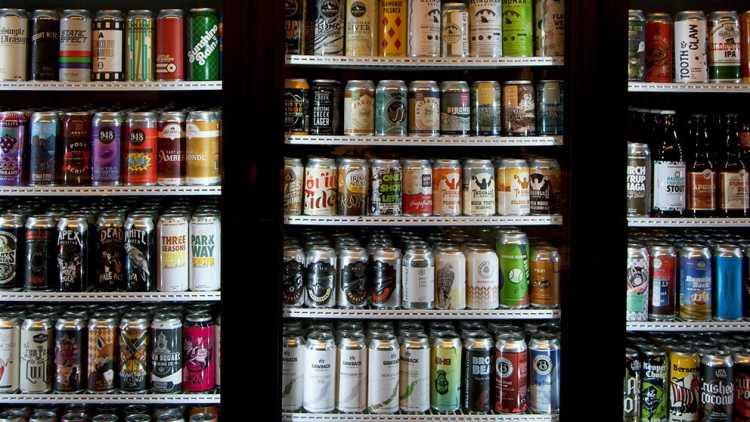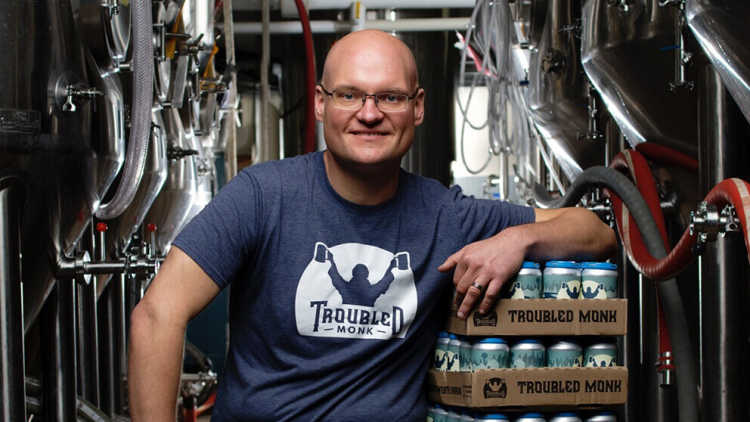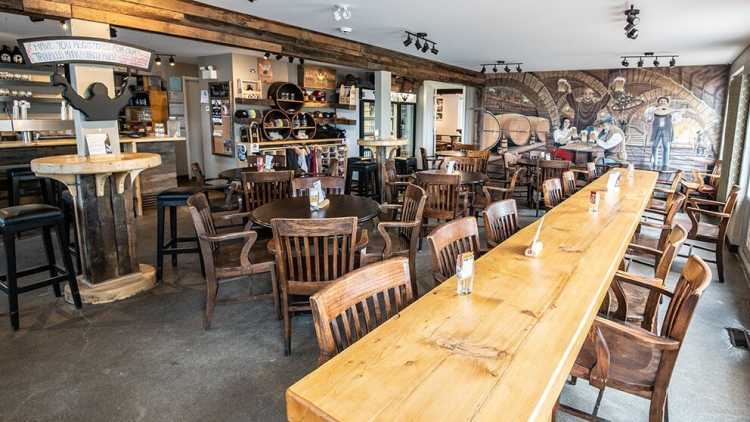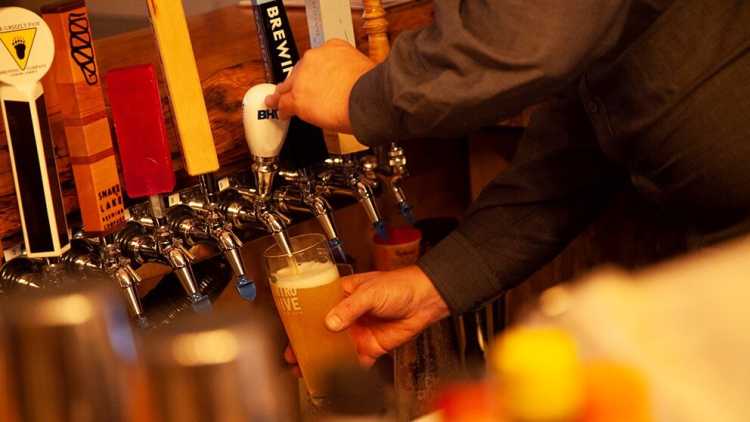Alberta’s craft beer supply chain: How the province’s brewers and retailers survived 2020 (Part 2)

COVID-19 took a toll on almost every Alberta manufacturing sector last year. This 4-part series describes the economics behind one of Alberta’s many barley-to-beer supply chains. We explore how craft beer’s unique ties to its consumers were able to shield it from some of the damage wrought by COVID – and how far the impacts of COVID reached.
Post 1 describes the shift in the supply chain that put consumers in the driver’s seat of craft beer.
Post 2 explains how a demand-driven supply chain was uniquely situated to withstand some of the worst effects of COVID.
In Post 3, we explore the role of the maltster as the indispensable conduit between craft brewer and barley producer.
Post 4 illustrates how much influence COVID had — and didn’t have — at the farm of a barley producer with close ties to an Alberta maltster.
What is craft beer?
Canada defines beer as “the product of alcoholic fermentation by yeast, and an infusion of barley or wheat malt and hops or hop extract in potable water,” and it must be brewed in a way that the result is recognized as beer in smell, taste and character (Government of Canada, 2016).
If beer is beer because we think it’s beer, defining craft breweries is even more elusive. To receive the seal from the Canadian Craft Brewers Association (CCBA-AMBC), a brewery must be small (output of fewer than 400,000 hl/year) – or fewer than 85 million pints. It must also be independently owned, with no large beverage company as controlling shareholder. But it’s more than that.
The CCBA-AMBC represents the interests of a sector whose culture is as important as its product. They say that craft, by definition, embodies “authenticity, community and environmental responsibility.” Craft is defined by its customers who value quality, freshness and flavour. They support breweries’ reinvestment in their communities.
In our first post, we saw how Alberta’s craft sector’s great strength lies in its close ties to its fans. Such community connections helped draw Charlie and Graeme Bredo to open Troubled Monk Brewery in Red Deer. In June 2015, the pair of avid homebrewers moved into their taproom with the capacity to brew 3,000 hL/ year. They’ve been able to expand multiple times since then.

Charlie Bredo, President and co-founder of Troubled Monk Brewery in Red Deer (photo courtesy of Charlie Bredo).
Taprooms today: A nod to an ancient tradition
A taproom, they figured, was the best way to get to know their customers and vice versa. By building Troubled Monk, they were connecting back to another era. The first taprooms were roadside inns, circa roughly 1300 A.D. catering to the new class of foreign merchants and traders. The Monk’s tableaux of joyful friars and thick furniture evoke that history for the kind of customers who appreciate such things.
Each taproom has its own character, but each also represents the classic strength of the “pull” economy. The space gives brewers daily access to changing consumer preferences and the chance to respond quickly with innovative flavour profiles. Serving fresh beer, taprooms made up 41%, on average, of an Albertan brewery's pre-pandemic revenue. And for new breweries, taprooms were crucial, comprising up to 64% of their pre-pandemic revenue on average.

The Troubled Monk Taproom in Red Deer features the sculpted beauty of furniture handmade by Charlie and Graeme’s father.
So, how could a fledgling sector with many recent start-ups deal with a global pandemic that would eliminate a key point for sales and a key means of interacting with customers?
What follows when the unthinkable happens?
Three major challenges arose in 2020 for Alberta’s craft sector.
1. The recency of Alberta’s craft history
By the time we had become familiar with the country’s top epidemiologists, 10 breweries had been in business for less than a year. As a result, small businesses without the time to have made an impression on consumers bore a heavy burden.
2. Alberta craft is still largely undiscovered
Rieley Kay, owner of family restaurant Cilantro and Chive, thinks there’s more the sector can do. “I strongly believe there’s a huge part of the market that is still untapped with breweries like Red Heart and Stronghold that are in smaller communities,” he says. “They can create a sense of destination travel for people from larger centres to be able to come out and explore those areas.”
But to do that, consumers must be able to get out, visit taprooms, try new beers and discover new breweries. Stay-at-home orders and economic shutdowns create a problem for a relatively unknown sector.
3. The economic climate worsened dramatically
In Alberta, the unemployment rate jumped to 15.5% in May of 2020 from a pre-pandemic level of 7.5%. Nobody knew when COVID first shut down the economy how long they’d be shuttered, who would have money to spend on alcohol, or how they’d be able to make sales. Charlie of Troubled Monk describes it as something out of science fiction.
“It was nerve-racking when just three or four weeks before everything was absolutely normal in our world and then suddenly, we're totally shut down,” he says. “You had no idea what it meant, and you had no idea how bad it would be or what would happen. There was a lot of stress.”
As the apocalypse dawned
At the start of the pandemic, some industry watchers warned one-third of Canada’s craft sector might be wiped out. Its breweries are, by definition, small businesses, the demographic that COVID has walloped.
Those worries had a basis in fact. According to a Canadian Craft Brewers Association survey, 44% of Canadian craft breweries reported a year-over-year revenue drop of over 50% in March 2020 alone, and many expected worse in April. The industry estimated craft brewers had an average of three months of cash on hand. Anheuser-Busch InBev and Molson Coors both reported falling sales at this time, but their much deeper pockets could provide better protection. No surprise then that a national average of 5% of craft breweries reported they were forced to close temporarily at the start of the pandemic, with another 14% reporting a very uncertain future.
The challenges didn’t stop there. Globally, beer producers have long been facing headwinds as more adults turn to other alcoholic beverages or turn away from booze altogether. To make matters worse, Alberta is Canada’s only province with privatized alcohol sales. Their craft brewers compete with each other and, of course, with the macro brews and international beers. But they must compete with higher numbers and a greater selection of craft beer imported from across Canada than craft brewers do in any other province.
Taken together, 2020 was a year of many battles for Alberta’s craft sector, most of them uphill. Yet, while there were losses and a lot of stress, the overall story was one of success. The calamity many suggested was imminent never materialized. In 2019, 120 brewers were registered in Alberta and in 2020, that climbed to 128, a 6.67% gain. Here’s why the sector avoided a disaster.
Growing craft in a declining market
Declining overall beer sales are no surprise. And growth in craft beer sales alongside falling overall sales in Canada’s alcohol market is expected. The continued income growth that Canada has experienced eventually reduces general beer consumption as drinkers opt for wine, spirits or craft beer instead. Ageing populations also reduce overall consumption. There are now fewer males aged 18-40 – beer’s peak consumer – as a proportion of Canada’s population than in the 70s and 80s when beer consumption was at its apex.
Want to learn more about beer? This study guide can help.
But craft, even at higher price points, can still appeal to older consumers, although their consumption of other beers falls. And many younger consumers drink less beer than they used to and are willing to pay more per unit, despite less disposable income than older consumers.
What a difference a pandemic makes
In economic terms, beer is a “procyclical normal” good: consumption rises in good times and falls in hard times, although movement in either direction is usually slight. But sales of Big Beer and craft beer react differently to income – and nobody knew what to expect from a pandemic.
Overall brewery sales values in Canada increased an impressive 5.0% in 2020, mostly due to growth in craft sales. But although the longstanding contraction in volumes continued – total beer volume declined 1.7% in the 2019-20 retail year – COVID-inspired beer sales reflected another important trend. The pandemic has amplified the move to buying local. Canadians bought more Canadian-made beer last year, with domestic beer retail volumes increasing 0.8%, while imported beer volumes fell 14.0%.
When you need your friends: Craft consumers meet COVID head-on
What does a relatively undiscovered sector do when its target customers can no longer come to it? To be successful, it must find ways to connect despite restrictions. The craft beer sector may be comprised of small businesses, a decided disadvantage in a pandemic, but connecting with their consumers is a core strength. In a way, the sector was ideally suited to deal with the challenges COVID posed. It was up to the entrepreneurial spirit – something craft has in droves – of individual brewers and retailers to respond.
According to Blair Berdusco, Executive Director of the Alberta Small Brewers Association, “The ones that were opened up late in 2019 and early 2020, they definitely had a lot more struggle to go through,” she said. “But communities were excited to see craft breweries no matter where they were.”
In other words, during the pandemic, “local” was generalized to “Alberta.” Berdusco says, “It was part of that community effort to just see these businesses in the north, the south, wherever, succeed as well.”
3 responses to the shock
After the lockdown was announced on March 17, 2020, individual brewers scrambled to find ways to get their product to consumers. Hans Doef of Blindman Brewing says their sales and marketing team shifted to do deliveries. With no industry visits possible (to restaurants and other retail outlets), they became the direct-to-consumer link after home delivery became an option. As a result, the brewery kept staff employed, served a growing customer need and maintained business relationships.
Charlie Bredo of Troubled Monk was also able to pivot to home deliveries and selling hand sanitizer. They relied on the network of community members via social media to stay connected when the taproom was closed to onsite dining. Their customers ordered online or visited the brewer to buy off sale.
Rieley Kay of Cilantro and Chive says, “I think if anything, the pandemic has really raised awareness of what is in our own backyard and driven people to explore more than they would have normally. Our guests are more knowledgeable about craft beer and more exploratory than before.”

Rieley Kay, co-owner of Cilantro and Chive in Lacombe, pours a cold one. The specialty restaurant features an expansive selection of beers from across Alberta, many of which they use in their menu.
“And we reach out,” Kay says. “We have conversations with a lot of restaurants, food suppliers, producers and our brewery friends – we’re able to have those conversations about what they see in the industry. I think a lot of it comes down to that communication and conversation around the brewery, the people, the experience that you can have in those craft breweries and in our own backyard.”
In the spirit of reaching out, Far Out Exporters, a Calgary craft beer, distillery and malt export business, is working to get more than just barley across Canadian borders. While they focus on Alberta craft, they also market production from across Canada. Blair Berdusco of ASBA says, “it's a fantastic opportunity.”
“It's going to grow over the next few years, as many of our breweries begin to grow themselves,” she says. One of the outcomes of the pandemic is beer production from collaborating brewers. The sector’s close-knit networks have made that possible and will possibly be a catalyst in driving further exports. There’s a lot of great beer being brewed in Alberta these days. In 2020, one of them was judged to be best beer in the world.
“I think it's a really exciting opportunity for the rest of the world to be one of the greatest showcases of the raw ingredients that we're able to produce here in Alberta,” she says. “Just knowing that people already want the materials and the products that are going into our beer just adds that much more to it,” she says.
A science to master - an art to respect
At the heart of Alberta’s success is a small, golden kernel of sweet deliciousness. The evolution of a malting industry that now produces delicious, consistent malts has built a successful craft sector foundation. It has given craft brewers the product consistency that once spawned the global success of macro beers. If high-quality malt barley is craft’s not-so-secret sauce, Canadian maltsters are the critical link between brewer and barley producer.
Next week in Post 3, we’ll look at Rahr Malting and Red Shed Malting, each a vital player in Canada’s western craft beer supply chain.

Martha Roberts
Economics Editor
Martha joined the Economics team in 2013, focusing on research insights about risk and success factors for agricultural producers and agri-businesses. She has 25 years’ experience conducting and communicating quantitative and qualitative research results to industry experts. Martha holds a Master of Sociology degree from Queen’s University in Kingston, Ontario and a Master of Fine Arts degree in non-fiction writing from the University of King’s College.
